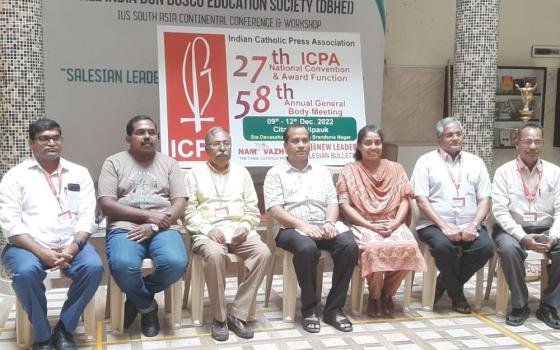Editor's note: Nicholas Collura is a new blogger for NCR Today. Read more about him.
Last week, the music section of The New York Times headlined "An Affirmation of Faith at Carnegie Hall": a performance of a number of works by the Estonian composer Arvo Pärt. According to the Times, the sellout crowd included Björk, Keanu Reeves, and a bevy of fully vested priests from St. Vladimir's Orthodox Theological Seminary. St. Vladimir's has curated a two-week series of concerts and events dedicated to Pärt's work in Washington and New York. The series culminates with a panel discussion Wednesday at the Metropolitan Museum of Art.
Pärt is one of several "holy minimalists" (the term describes such diverse composers as Tavener, Kancheli and Górecki) initially influenced by serialism and other musical avant-gardes but later inspired to develop harmonically simple sacred music. For Pärt, the conversion to a new musical style initially had to do with his struggle against Soviet censorship, which targeted both his technical innovations and his Christianity.
Pärt plunged into a long period of artistic silence, reflecting on the "cosmic mystery" that, he sensed, lies "hidden behind the art of connecting [even] two or three notes." Over the course of years of study, he discovered the sanative qualities of medieval music: "It was clear how much deeper and more pure" their world is than ours, he later opined. When he finally emerged from his creative silence in the '70s, the "amassment of violent power" in his early work -- which "strain[ed] at its own limits like an avalanche" -- was replaced by a reduction of sonic textures, gentler yet no less sublime.
On a humorous note, conductor Stephen Layton relates that Pärt initially conceived of his famous "tintinnabuli" motif -- a ringing, bell-like triad present in some form or another throughout his oeuvre -- when he heard three descending notes introduce an announcement on a supermarket loudspeaker. Gregorian chant and supermarket jingles -- the Carnegie concert, then, was not the first time that sacred and profane have rubbed shoulders in the life of Arvo Pärt.
For a contemporary composer, Pärt is quite accessible and increasingly well known. Many filmmakers have woven his work into the soundtracks of their recent films, such as "There Will Be Blood," "The Place Beyond the Pines," "To the Wonder" and "The Great Beauty." And journalist Siim Nestor writes that Pärt is beloved by a surprisingly broad range of industrial, post-rock, folktronic, and black metal musicians. Radiohead's Thom Yorke, for instance, says Pärt's music "is like knocking on a wall and a hole appears in the wall where you can see a new world which you were completely unaware of the existence of."
What's more, in a very revealing anecdote, Pärt's wife, Nora, tells of a time Soviet border guards in Belarus stopped the two of them. They played a few recordings of Pärt's music to try to appease them, and sure enough, the guards dissolved into kindness. "I saw the power of music to transform people," Nora says.
Recognizing the importance of a composer whose music is at once deeply spiritual, technically innovative, and hugely popular, the Vatican inducted Pärt into its Pontifical Council for Culture in 2011. As the church celebrates Pentecost this week, invoking the presence of the "Creator Spirit," it may be good for us, too, to know and appreciate Pärt's music for its potential to bring the sacred to a vast audience and to enrich our own spiritual lives.
Some favorite pieces are Pärt's "Spiegel im Spiegel" (1978), "Stabat Mater" (1985), and "My Heart's in the Highlands" (2000). But given that it is the time of Pentecost, perhaps it is most fitting to single out his recent setting of the "Veni Creator Spiritus" (2006).




